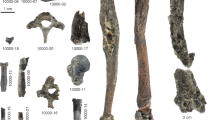Abstract
An adult male chimpanzee in the natural habitat has been observed to walk predominantly bipedally after a total forelimb paralysis in 1966. The major differences from previously described bipedal chimpanzee gait are (1) one third of the femoral extension is posterior to the hip joint in propulsion, (2) excursion of the swinging foot is close to midline, due to adduction of the lower hindlimb in swing and propulsive phases, (3) depressed pelvic tilt is on the side of the swinging limb, (4) thoracic vertebrae rotate and are vertical and erect, and (5) there is only a moderate lateral sway of the midline. This locomotory complex is interpreted as individual variability and suggests an evolutionary model for the origin of hominid bipedal locomotion.
Similar content being viewed by others
References
Albrecht, H. &S. C. Dunnett, 1971.Chimpanzees in Western Africa. R. Piper & Co., Munchen.
Bauer, H. R., 1976. Ethological aspects of Gombe chimpanzee aggregations with implications for hominization. PH.D. dissertation, Stanford University.
Elftman, H., 1944. The bipedal walking of the chimpanzee.J. Mammal., 25: 67–71.
————, 1935. Chimpanzee and human feet in bipedal walking.Am. J. Phys. Anthropol., 20: 69–79.
Goodall, J., 1975. Chimpanzee behavior. In:Hominisation und Verhalten,I. Eibl-Eibesfeldt (ed.), Gustav Fisher V.
Hewes, G. W., 1961. Food transport and the origin of hominid bipedalism.Amer. Anthrop., 63: 687–710.
Jenkins, F. A., 1972. Chimpanzee bipedalism: Cinemaradiographic analysis and implications for the evolution of gait.Science, 178; 877–879.
Kortlandt, A., 1962. Chimpanzees in the wild.Sci. Am., 206: 128–138.
Napier, J., 1964. The evolution of bipedal walking in the hominids.Arch. Biol., 75: 673–708.
Robinson, J. T., 1972.Early Hominid Posture and Locomotion. Chicago University Press.
————, 1972. Some aspects of pongid and hominid bipedality.J. Hum. Evol., 1: 361–369.
Sigmon, B. A., 1971. Bipedal behavior and the emergence of erect postutre in man.Am. J. Phys. Anthrop., 34: 55–60.
Tuttle, R. H., 1970. Postural, propulsive and prehensile capabilities in the cheiridia of chimpanzees and other great apes. In:The Chimpanzee,G. H. Bourne (ed.), Vol. 2, S. Karger, pp. 178–253.
van Lawick-Goodall, J., 1968. The behavior of the free-living chimpanzees of the Gombe Stream Reserve.Anim. Behav. Monogr., 1: Part 3.
Wrangham, R. W., 1974. Artificial feeding of chimpanzees and baboons in their natural habitat.Anim. Behav., 22: 83.
Zihlman, A. L. &W. S. Hunter, 1972. A biomechanical interpretation of the pelvis ofAustralopithecus.Folia primat., 18: 1–19.
Author information
Authors and Affiliations
About this article
Cite this article
Bauer, H.R. Chimpanzee bipedal locomotion in the Gombe National Park, East Africa. Primates 18, 913–921 (1977). https://doi.org/10.1007/BF02382940
Received:
Accepted:
Issue Date:
DOI: https://doi.org/10.1007/BF02382940




